Knowledge Networks in Organic Fruit Production across Europe: A Survey Study
Abstract
:1. Introduction
2. Materials and Methods
3. Results and Discussion
3.1. Territorial Distribution of the Knowledge Networks
3.2. Knowledge Networks’ Structure and Composition
3.3. Aims and Tasks of Networks Related to Knowledge Exchange
3.4. Networks’ Communication and Knowledge Exchange Methods
3.5. Networks’ Funding Sources
4. Conclusions
Supplementary Materials
Author Contributions
Funding
Institutional Review Board Statement
Informed Consent Statement
Data Availability Statement
Conflicts of Interest
References
- Trávníček, J.; Willer, H.; Schaack, A. Organic Farming and Market Development in Europe and the European Union. In The World of Organic Agriculture Statistics and Emerging Trends 2021; Research Institute of Organic Agriculture FiBL, Frick, and IFOAM—Organics International: Bonn, Germany, 2021; pp. 229–266. [Google Scholar]
- European Commission. Communication from the Commission to the European Parliament, the Council, the European Economic and Social Committee and the Committee of the Regions: A Farm to Fork Strategy for a Fair, Healthy and Environmentally-Friendly Food System. COM2020381 Final 2020. Available online: https://eur-lex.europa.eu/legal-content/EN/TXT/?uri=CELEX%3A52020DC0381 (accessed on 28 December 2021).
- Midmore, P.; Padel, S.; McCalman, H.; Isherwood, J.; Fowler, S.; Lampkin, N. Attitudes towards Conversion to Organic Production Systems: A Study of Farmers in England; Institute of Rural Studies the University of Wales: Aberystwyth, UK, 2001. [Google Scholar]
- Lohr, L.; Park, T.A. Choice of Insect Management Portfolios by Organic Farmers: Lessons and Comparative Analysis. Ecol. Econ. 2002, 43, 87–99. [Google Scholar] [CrossRef]
- Torres, A.P.; Marshall, M.I. Identifying Drivers of Organic Decertification: An Analysis of Fruit and Vegetable Farmers. HortScience 2018, 53, 504–510. [Google Scholar] [CrossRef]
- Curry, N.; Kirwan, J. The Role of Tacit Knowledge in Developing Networks for Sustainable Agriculture. Sociol. Rural. 2014, 54, 341–361. [Google Scholar] [CrossRef]
- Eshuis, J.; Stuiver, M. Learning in Context Through Conflict and Alignment: Farmers and Scientists in Search of Sustainable Agriculture. Agric. Hum. Values 2005, 22, 137–148. [Google Scholar] [CrossRef]
- Nerbonne, J.; Lentz, R. Rooted in Grass: Challenging Patterns of Knowledge Exchange as a Means of Fostering Social Change in a Southeast Minnesota Farm Community. Agric. Hum. Values 2003, 20, 65–78. [Google Scholar] [CrossRef]
- Knickel, K.; Brunori, G.; Rand, S.; Proost, J. Towards a Better Conceptual Framework for Innovation Processes in Agriculture and Rural Development: From Linear Models to Systemic Approaches. J. Agric. Educ. Ext. 2009, 15, 131–146. [Google Scholar] [CrossRef]
- EU SCAR. Agricultural Knowledge and Innovation Systems in Transition—A Reflection Paper; European Commission: Brussels, Belgium, 2012. [Google Scholar]
- Morgan, K.; Murdoch, J. Organic vs. Conventional Agriculture: Knowledge, Power and Innovation in the Food Chain. Geoforum 2000, 31, 159–173. [Google Scholar] [CrossRef]
- Leeuwis, C.; van den Ban, A.W. Communication for Rural Innovation: Rethinking Agricultural Extension, 3rd ed.; Blackwell Science: Oxford, UK, 2004. [Google Scholar]
- Hall, A. Public-Private Sector Partnerships in an Agricultural System of Innovation: Concepts and Challenges. Int. J. Technol. Manag. Sustain. Dev. 2006, 5, 3–20. [Google Scholar] [CrossRef] [Green Version]
- OECD. The Well-Being of Nations: The Role of Human and Social Capital; Centre for Educational Research and Innovation: Paris, France, 2001. [Google Scholar] [CrossRef]
- Klerkx, L.; Leeuwis, C. Matching Demand and Supply in the Agricultural Knowledge Infrastructure: Experiences with Innovation Intermediaries. Food Policy 2008, 33, 260–276. [Google Scholar] [CrossRef]
- Oreszczyn, S.; Lane, A.; Carr, S. The Role of Networks of Practice and Webs of Influencers on Farmers’ Engagement with and Learning about Agricultural Innovations. J. Rural Stud. 2010, 26, 404–417. [Google Scholar] [CrossRef]
- Augustyn, A.; Nemes, G. Engaging Researchers with Learning and Innovation Networks for Sustainable Agriculture (LINSAs). Farming Syst. Facing Glob. Chall. Capacit. Strateg. 2014, 478–486. Available online: https://www.academia.edu/17690126/Engaging_researchers_with_Learning_and_Innovation_Networks_for_Sustainable_Agriculture_LINSAs (accessed on 28 December 2021).
- Rudman, C. Agricultural Knowledge Systems in Transition: Towards a More Effective and Efficient Support of Learning and Innovation Networks for Sustainable Agriculture (SOLINSA). Project Description. 2010. Available online: http://www.solinsa.org/the-project/the-project/ (accessed on 28 December 2021).
- Tisenkopfs, T.; Brunori, G.; Knickel, K.; Sumane, S. Co-Production of Rural Innovation: Towards an Enriched Theoretical Model. In Innovation Processes in Agriculture and Rural Development. Results of a Cross-National Analysis of the Situation in Seven Countries, Research Gaps and Recommendations; Knickel, K., Tisenkopfs, T., Peter, S., Eds.; 2009; pp. 129–159. Available online: https://ub.unibas.ch/digi/a125/sachdok/2012/BAU_1_5998000.pdf (accessed on 28 December 2021).
- Rantanen, M.; Granberg, L. Innovation Systems and Processes in the Field of New Rural Services: A Cross-National Analysis of Differences in Finland, Germany, Latvia and the Netherlands. In IN-SIGHT: Strengthening Innovation Processes for Growth and Development; Ruralia Institute, University of Helsinki: Helsinki, Finland, 2008. [Google Scholar]
- Brunori, G.; Rossi, A.; Guidi, F. On the New Social Relations around and beyond Food. Analysing Consumers’ Role and Action in Gruppi Di Acquisto Solidale (Solidarity Purchasing Groups). Sociol. Rural. 2012, 52, 1–30. [Google Scholar] [CrossRef]
- Beckford, C.; Barker, D. The Role and Value of Local Knowledge in Jamaican Agriculture: Adaptation and Change in Small-Scale Farming. Geogr. J. 2007, 173, 118–128. [Google Scholar] [CrossRef]
- Goven, J.; Morris, C.M. Regulating Biopharming: The Prism of Farmer Knowledge. Sci. Cult. 2012, 21, 497–527. [Google Scholar] [CrossRef]
- Blanc, J. Family Farmers and Major Retail Chains in the Brazilian Organic Sector: Assessing New Development Pathways. A Case Study in a Peri-Urban District of São Paulo. J. Rural Stud. 2009, 25, 322–332. [Google Scholar] [CrossRef] [Green Version]
- Kroma, M.M. Organic Farmer Networks: Facilitating Learning and Innovation for Sustainable Agriculture. J. Sustain. Agric. 2006, 28, 5–28. [Google Scholar] [CrossRef]
- Lamine, C.; Bellon, S. Conversion to Organic Farming: A Multidimensional Research Object at the Crossroads of Agricultural and Social Sciences. A Review. Agron. Sustain. Dev. 2009, 29, 97–112. [Google Scholar] [CrossRef] [Green Version]
- Arbenz, M.; Gould, D.; Stopes, C. ORGANIC 3.0—the Vision of the Global Organic Movement and the Need for Scientific Support. Org. Agric. 2017, 7, 199–207. [Google Scholar] [CrossRef]
- Pinsonneault, A.; Kraemer, K. Survey Research Methodology in Management Information Systems: An Assessment. J. Manag. Inf. Syst. 1993, 10, 75–105. [Google Scholar] [CrossRef] [Green Version]
- Salant, P.; Dillman, D.A. How to Conduct Your Own Survey; John Wiley and Sons: Hoboken, NJ, USA, 1994; ISBN 978-0-471-01273-3. [Google Scholar]
- Glaser, B.G.; Strauss, A.L. The Discovery of Grounded Theory: Strategies for Qualitative Research; Aldine de Gruyter: New York, NY, USA, 1967; ISBN 978-0-202-30260-7. [Google Scholar]
- Schwandt, T.A. Constructivist, Interpretativist Approaches to Human Enquiry. In The landscape of Qualitative Research: Theories and Issues; Sage Publications: Thousand Oaks, CA, USA, 1998; pp. 221–259. [Google Scholar]
- Raymond, C.M.; Fazey, I.; Reed, M.S.; Stringer, L.C.; Robinson, G.M.; Evely, A.C. Integrating Local and Scientific Knowledge for Environmental Management. J. Environ. Manag. 2010, 91, 1766–1777. [Google Scholar] [CrossRef]
- Darnhofer, I.; Bellon, S.; Dedieu, B.; Milestad, R. Adaptiveness to Enhance the Sustainability of Farming Systems. A Review. Agron. Sustain. Dev. 2010, 30, 545–555. [Google Scholar] [CrossRef] [Green Version]
- Stuiver, M.; Leeuwis, C.; van der Ploeg, J.D. The Power of Experience: Farmers’ Knowledge and Sustainable Innovations in Agriculture; Van Gorcum: Assen, The Netherlands, 2004. [Google Scholar]
- Labarthe, P.; Laurent, C. Privatization of Agricultural Extension Services in the EU: Towards a Lack of Adequate Knowledge for Small-Scale Farms? Food Policy 2013, 38, 240–252. [Google Scholar] [CrossRef]
- Sutherland, L.-A.; Madureira, L.; Dirimanova, V.; Bogusz, M.; Kania, J.; Vinohradnik, K.; Creaney, R.; Duckett, D.; Koehnen, T.; Knierim, A. New Knowledge Networks of Small-Scale Farmers in Europe’s Periphery. Land Use Policy 2017, 63, 428–439. [Google Scholar] [CrossRef]
- Österle, N.; Koutsouris, A.; Livieratos, Y.; Kabourakis, E. Extension for Organic Agriculture: A Comparative Study between Baden-Württemberg, Germany and Crete, Greece. J. Agric. Educ. Ext. 2016, 22, 345–362. [Google Scholar] [CrossRef]
- Ortolani, L.; Bocci, R.; Bàrberi, P.; Howlett, S.; Chable, V. Changes in Knowledge Management Strategies Can Support Emerging Innovative Actors in Organic Agriculture: The Case of Participatory Plant Breeding in Europe. Org. Farming 2017, 3, 20–33. [Google Scholar] [CrossRef] [Green Version]
- Warner, K.D. Extending Agroecology: Grower Participation in Partnerships Is Key to Social Learning. Renew. Agric. Food Syst. 2006, 21, 84–94. [Google Scholar] [CrossRef] [Green Version]
- McKitterick, L.; Quinn, B.; McAdam, R.; Dunn, A. Innovation Networks and the Institutional Actor-Producer Relationship in Rural Areas: The Context of Artisan Food Production. J. Rural Stud. 2016, 48, 41–52. [Google Scholar] [CrossRef]
- Ingram, J. Are Farmers in England Equipped to Meet the Knowledge Challenge of Sustainable Soil Management? An Analysis of Farmer and Advisor Views. J. Environ. Manag. 2008, 86, 214–228. [Google Scholar] [CrossRef]
- Lehébel-Péron, A.; Sidawy, P.; Dounias, E.; Schatz, B. Attuning Local and Scientific Knowledge in the Context of Global Change: The Case of Heather Honey Production in Southern France. J. Rural Stud. 2016, 44, 132–142. [Google Scholar] [CrossRef]
- Šūmane, S.; Kunda, I.; Knickel, K.; Strauss, A.; Tisenkopfs, T.; des los Rios, I.; Rivera, M.; Chebach, T.; Ashkenazy, A. Local and Farmers’ Knowledge Matters! How Integrating Informal and Formal Knowledge Enhances Sustainable and Resilient Agriculture. J. Rural Stud. 2018, 59, 232–241. [Google Scholar] [CrossRef]
- Bocci, R.; Rey, F.; Chable, V. Policy Recommendations to Sustain Diversity Strategies within Food Systems. SOLIBAM Proj. 2014. Available online: www.solibam.eu (accessed on 28 December 2021).
- Moschitz, H.; Roep, D.; Brunori, G.; Tisenkopfs, T. Learning and Innovation Networks for Sustainable Agriculture: Processes of Co-Evolution, Joint Reflection and Facilitation. J. Agric. Educ. Ext. 2015, 21, 1–11. [Google Scholar] [CrossRef]
- Wood, B.; Blair, H.T.; Gray, D.I.; Kemp, P.D.; Kenyon, P.R.; Morris, S.T.; Sewell, A. Agricultural Science in the Wild: A Social Network Analysis of Farmer Knowledge Exchange. PLoS ONE 2014, 9, e105203. [Google Scholar] [CrossRef] [PubMed] [Green Version]
- EU SCAR AKIS. Preparing for Future AKIS in Europe; European Commission: Brussels, Belgium, 2019. [Google Scholar]
- Goulet, F. Narratives of Experience and Production of Knowledge within Farmers’ Groups. J. Rural Stud. 2013, 32, 439–447. [Google Scholar] [CrossRef]
- Le Hénaff, D.; Cebeci, Z. Agroecology for Farmers: The Linguistic Issue. In Sustainable Agriculture Reviews 14: Agroecology and Global Change; Ozier-Lafontaine, H., Lesueur-Jannoyer, M., Eds.; Springer International Publishing: Cham, Switzerland, 2014; pp. 331–343. ISBN 978-3-319-06016-3. [Google Scholar]
- Bliss, K.; Padel, S.; Cullen, B.; Ducottet, C.; Mullender, S.; Rasmussen, I.A.; Moeskops, B. Exchanging Knowledge to Improve Organic Arable Farming: An Evaluation of Knowledge Exchange Tools with Farmer Groups across Europe. Org. Agric. 2019, 9, 383–398. [Google Scholar] [CrossRef]
- Kaup, B.Z. The Reflexive Producer: The Influence of Farmer Knowledge Upon the Use of Bt Corn. Rural Sociol. 2008, 73, 62–81. [Google Scholar] [CrossRef]
- Mills, J.; Gibbon, D.; Ingram, J.; Reed, M.; Short, C.; Dwyer, J. Organising Collective Action for Effective Environmental Management and Social Learning in Wales. J. Agric. Educ. Ext. 2011, 17, 69–83. [Google Scholar] [CrossRef]
- Pardede, J.; Sitohang, B.; Akbar, S.; Khodra, M.L. Implementation of Transfer Learning Using VGG16 on Fruit Ripeness Detection. Int. J. Intell. Syst. Appl. 2021, 13, 52–61. [Google Scholar] [CrossRef]
- Curry, N.; Ingram, J.; Kirwan, J.; Maye, D. Knowledge Networks for Sustainable Agriculture in England. Outlook Agric. 2012, 41, 243–248. [Google Scholar] [CrossRef] [Green Version]
- Crawford, C.; Grossman, J.; Warren, S.T.; Cubbage, F. Grower Communication Networks: Information Sources for Organic Farmers. J. Ext. 2015, 53, 3FEA9. [Google Scholar]
- Sagor, E.S.; Becker, D.R. Personal Networks and Private Forestry in Minnesota. J. Environ. Manag. 2014, 132, 145–154. [Google Scholar] [CrossRef] [PubMed]
- Klerkx, L.; Proctor, A. Beyond Fragmentation and Disconnect: Networks for Knowledge Exchange in the English Land Management Advisory System. Land Use Policy 2013, 30, 13–24. [Google Scholar] [CrossRef]
- Ortolani, L.; Micheloni, C. Identification of the Best Methods for Learning and Knowledge Exchange. D 3.2 of OK-Net Arable; AIAB: Rome, Italy, 2016. [Google Scholar]
- Butler, A.; Lobley, M. Resource Management, Knowledge and Internet Use on Farms in SouthWest England: A Report for the SWARM Knowledge Hub; Centre for Rural Policy Research, University of Exeter: Exeter, UK, 2012. [Google Scholar]
- Eurostat Organic Farming Statistics. 2021. Available online: https://ec.europa.eu/eurostat/statistics-explained/index.php?title=Organic_farming_statistics&oldid=554979 (accessed on 28 December 2021).
- Läpple, D.; Rensburg, T.V. Adoption of Organic Farming: Are There Differences between Early and Late Adoption? Ecol. Econ. 2011, 70, 1406–1414. [Google Scholar] [CrossRef]
- Godfray, H.C.J.; Beddington, J.R.; Crute, I.R.; Haddad, L.; Lawrence, D.; Muir, J.F.; Pretty, J.; Robinson, S.; Thomas, S.M.; Toulmin, C. Food Security: The Challenge of Feeding 9 Billion People. Science 2010, 327, 812–818. [Google Scholar] [CrossRef] [Green Version]
- Spaapen, J.B. A New Evaluation Culture Is Inevitable. Org. Farming 2015, 1, 36–37. [Google Scholar] [CrossRef]
- Kania, J.; Vinohradnik, K.; Tworzyk, A. Advisory Services in System of Agricultural Knowledge and Information in Poland. In Proceedings of the 11th European IFSA Symposium, Berlin, Germany, 1–4 April 2014; pp. 120–130. [Google Scholar]
- EU SCAR. Agricultural Knowledge and Innovation Systems towards 2020—An Orientation Paper on Linking Innovation and Research; European Commission: Brussels, Belgium, 2013. [Google Scholar]
- Darnhofer, I.; Lindenthal, T.; Bartel-Kratochvil, R.; Zollitsch, W. Conventionalisation of Organic Farming Practices: From Structural Criteria towards an Assessment Based on Organic Principles. A Review. Agron. Sustain. Dev. 2010, 30, 67–81. [Google Scholar] [CrossRef] [Green Version]
- Ratnadass, A.; Fernandes, P.; Avelino, J.; Habib, R. Plant Species Diversity for Sustainable Management of Crop Pests and Diseases in Agroecosystems: A Review. Agron. Sustain. Dev. 2012, 32, 273–303. [Google Scholar] [CrossRef] [Green Version]
- Granatstein, D.; Andrews, P.; Groff, A. Productivity, Economics, and Fruit and Soil Quality of Weed Management Systems in Commercial Organic Orchards in Washington State, USA. Org. Agric. 2014, 4, 197–207. [Google Scholar] [CrossRef]
- Scherr, S.J.; McNeely, J.A. Biodiversity Conservation and Agricultural Sustainability: Towards a New Paradigm of ‘Ecoagriculture’ Landscapes. Philos. Trans. R. Soc. B Biol. Sci. 2008, 363, 477–494. [Google Scholar] [CrossRef] [Green Version]
- Rahmann, G.; Reza Ardakani, M.; Bàrberi, P.; Boehm, H.; Canali, S.; Chander, M.; David, W.; Dengel, L.; Erisman, J.W.; Galvis-Martinez, A.C.; et al. Organic Agriculture 3.0 Is Innovation with Research. Org. Agric. 2017, 7, 169–197. [Google Scholar] [CrossRef] [Green Version]
- Hermans, F.; Klerkx, L.W.A.; Roep, D. Structural Conditions for Dynamic Innovation Networks: A Review of Eight European Agricultural Knowledge and Innovation Systems. In Proceedings of the 10th European IFSA Symposium, Aarhus, Denmark, 1–4 July 2012; pp. 1–11. [Google Scholar]
- IFOAM Principles of Organic Agriculture. Preamble; IFOAM Organic International: Bonn, Germany, 2017; Available online: https://www.ifoam.bio/principles-organic-agriculture-brochure (accessed on 28 December 2021).

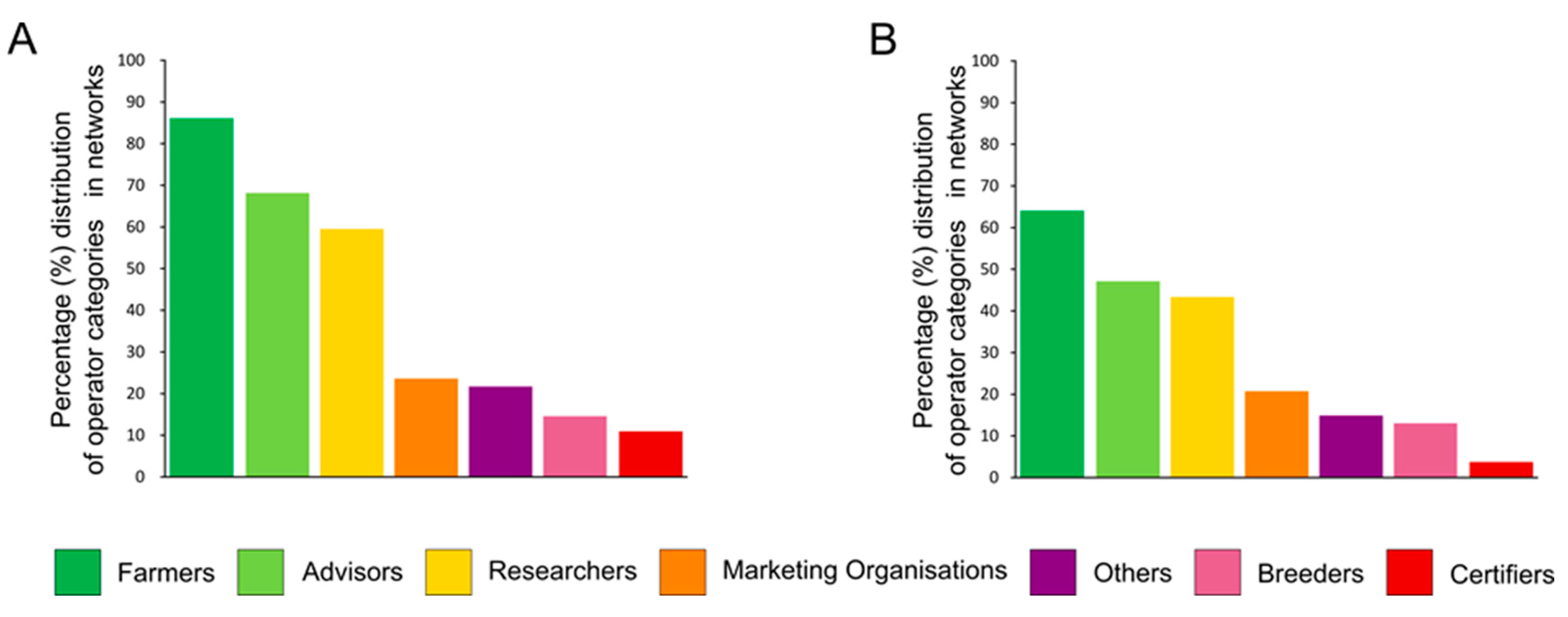
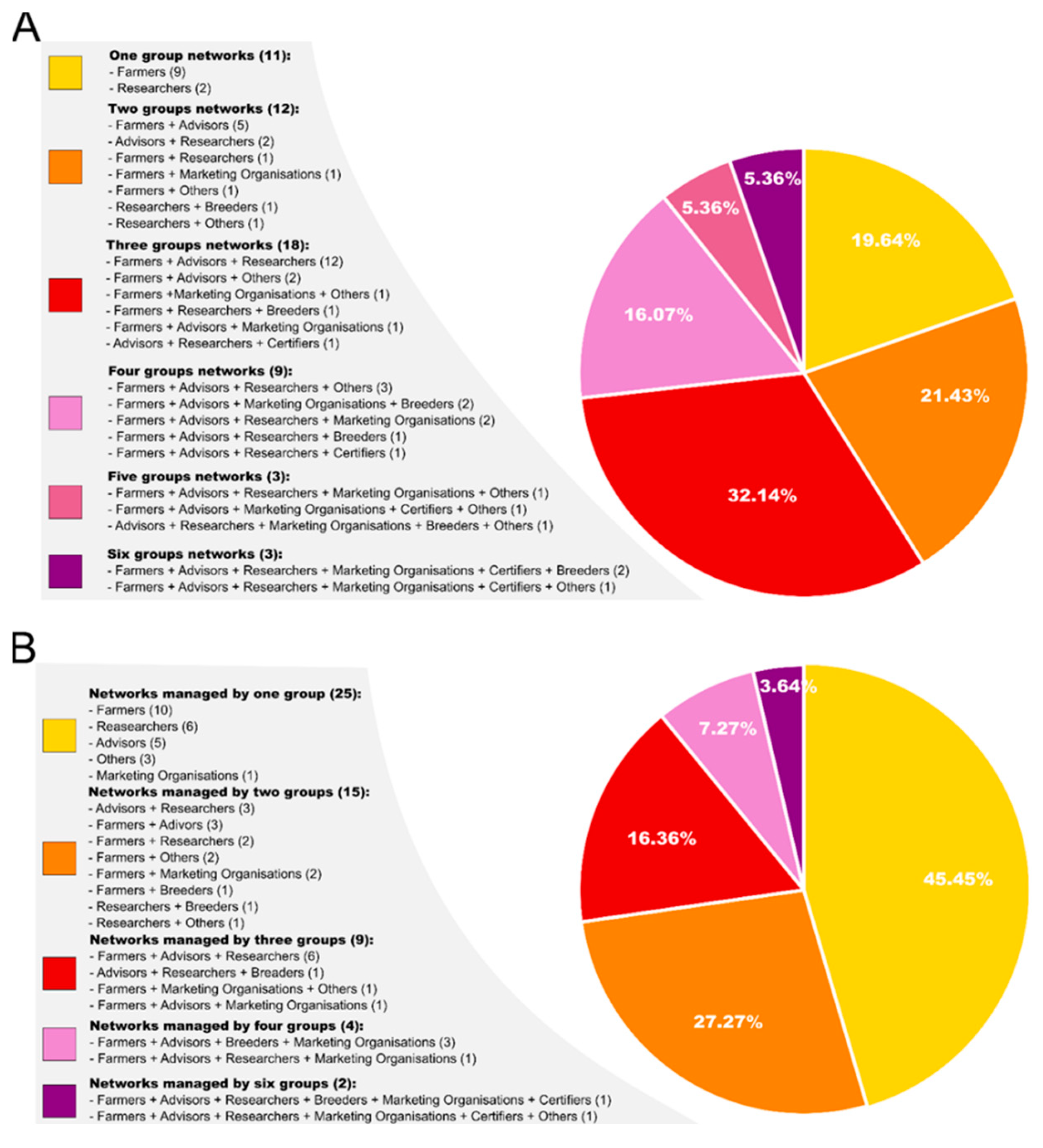
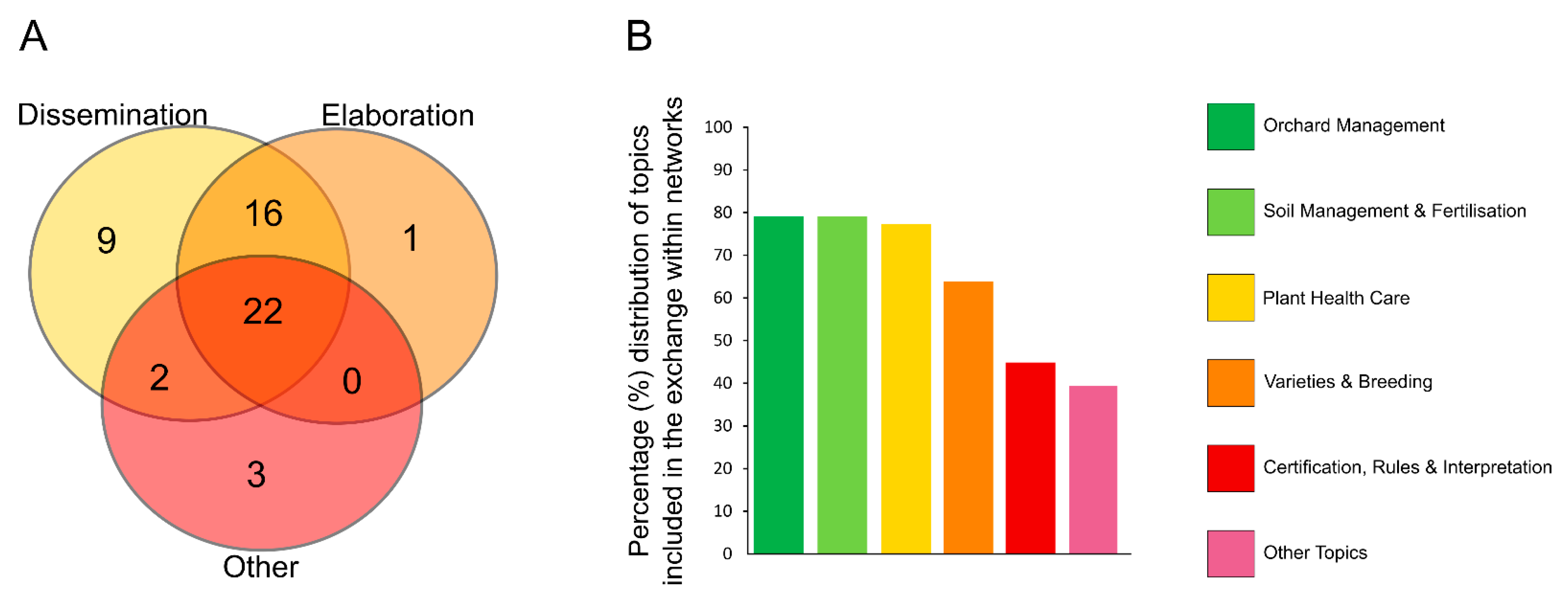
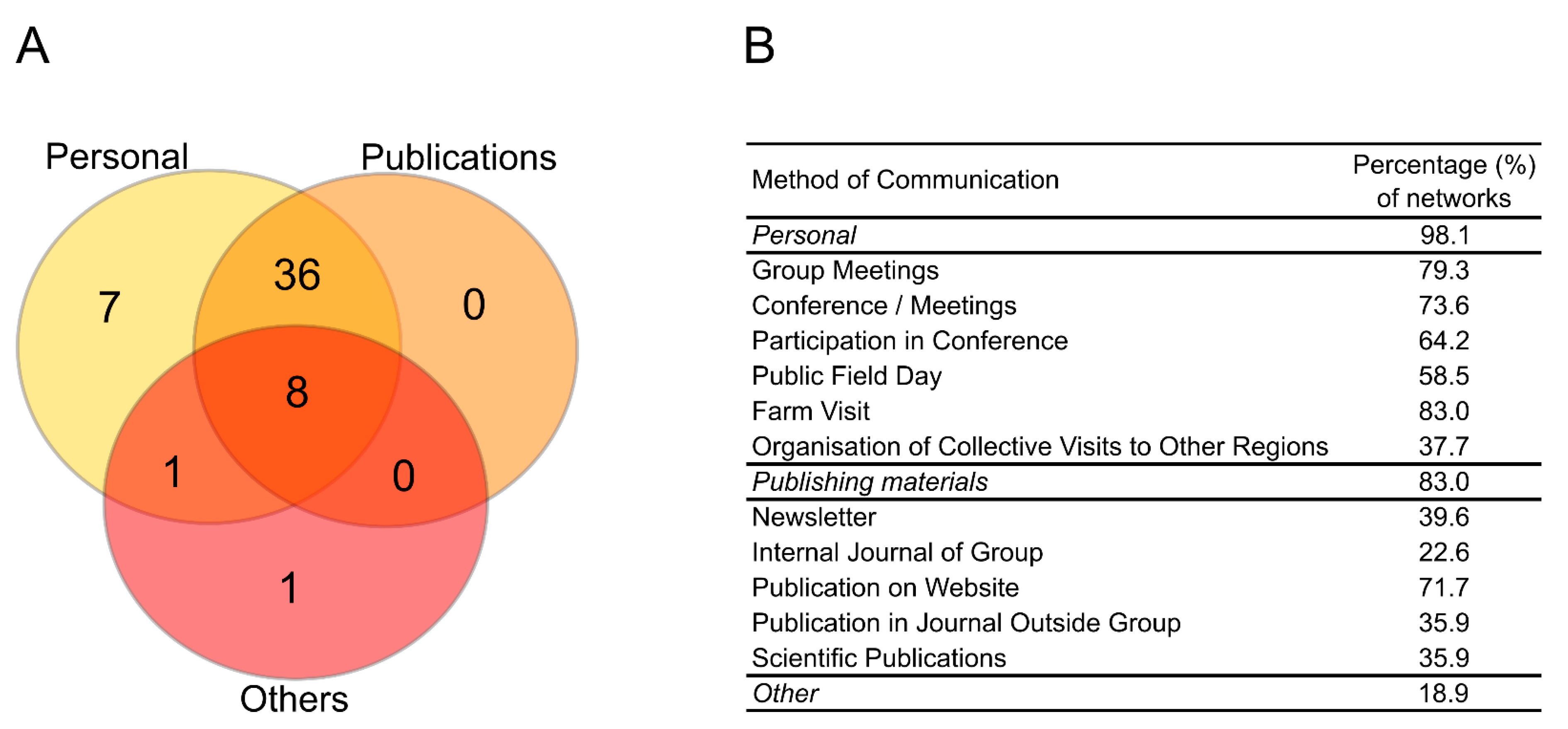
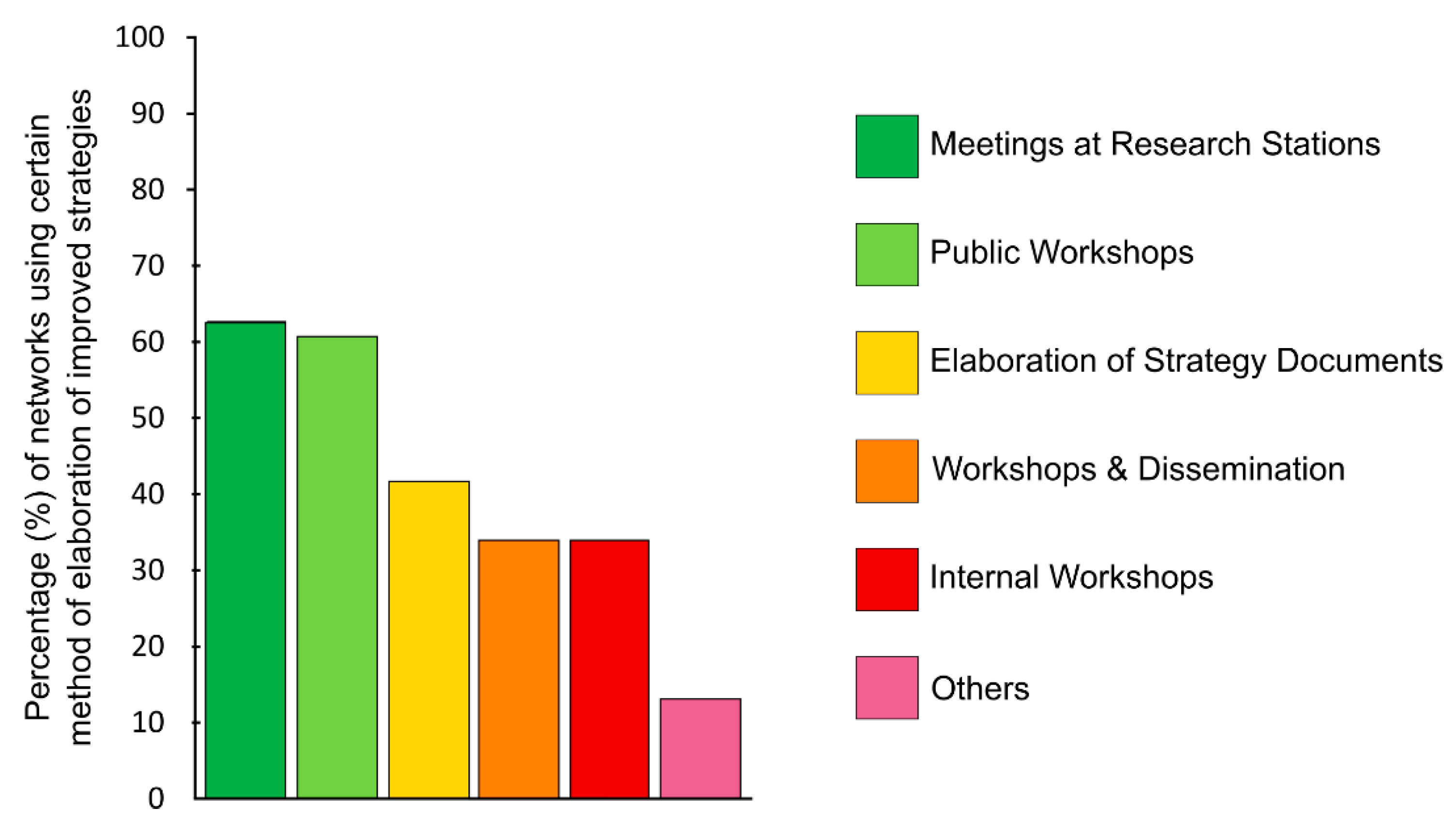
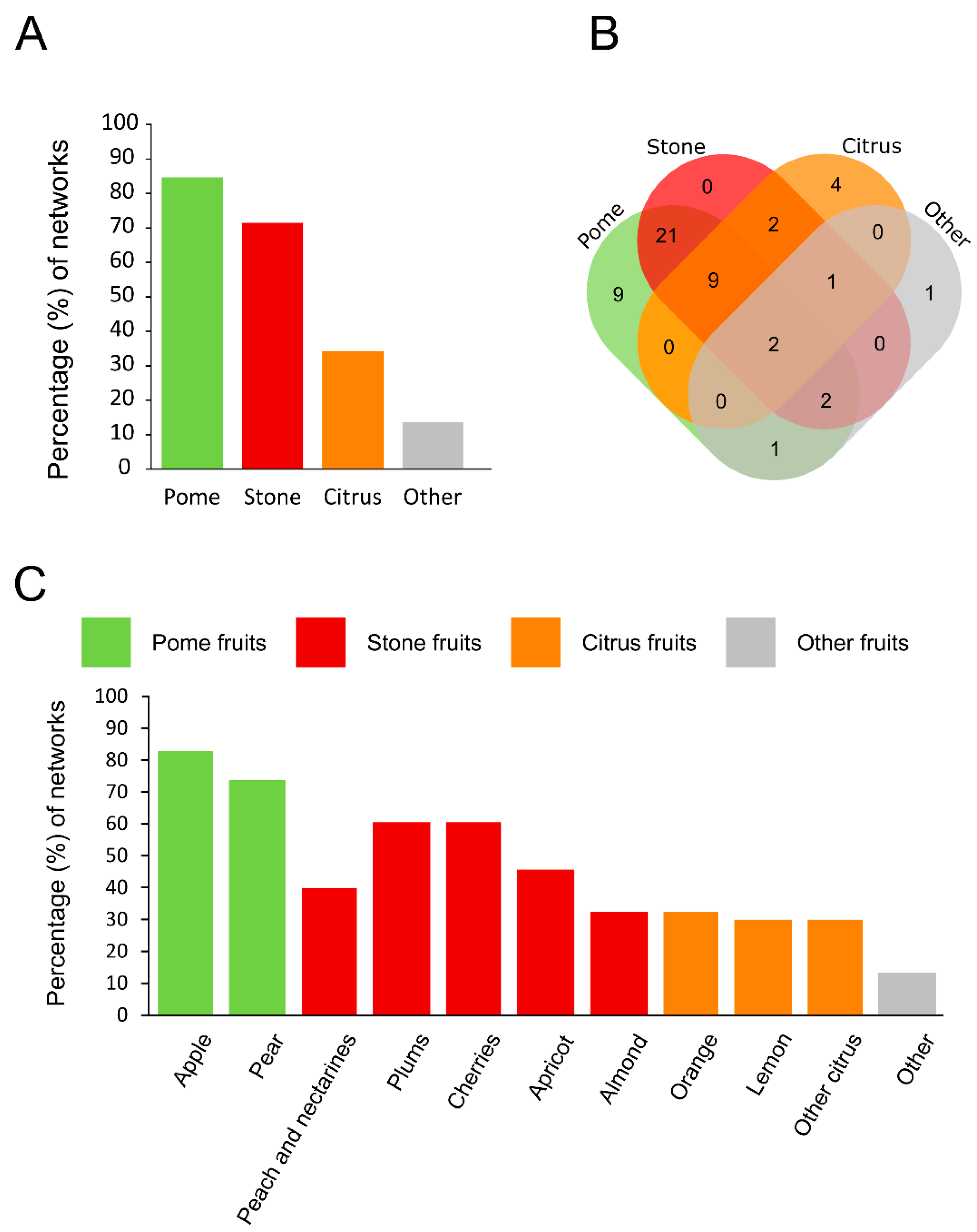

| Network Membership Structure | Percentage (%) |
|---|---|
| Single sector | |
| Public | 28.6 |
| Private | 35.7 |
| NGO | 16.1 |
| Other 1 | 8.9 |
| Two sectors | |
| Public + Private | 3.6 |
| Public + NGO | 1.8 |
| NGO + Other | 3.8 |
| Three sectors | |
| Private + NGO + Other | 1.8 |
Publisher’s Note: MDPI stays neutral with regard to jurisdictional claims in published maps and institutional affiliations. |
© 2022 by the authors. Licensee MDPI, Basel, Switzerland. This article is an open access article distributed under the terms and conditions of the Creative Commons Attribution (CC BY) license (https://creativecommons.org/licenses/by/4.0/).
Share and Cite
Malusà, E.; Furmanczyk, E.M.; Tartanus, M.; Brouwer, G.; Parveaud, C.-E.; Warlop, F.; Kelderer, M.; Kienzle, J.; Alcazar Marin, E.; Dekker, T.; et al. Knowledge Networks in Organic Fruit Production across Europe: A Survey Study. Sustainability 2022, 14, 2960. https://doi.org/10.3390/su14052960
Malusà E, Furmanczyk EM, Tartanus M, Brouwer G, Parveaud C-E, Warlop F, Kelderer M, Kienzle J, Alcazar Marin E, Dekker T, et al. Knowledge Networks in Organic Fruit Production across Europe: A Survey Study. Sustainability. 2022; 14(5):2960. https://doi.org/10.3390/su14052960
Chicago/Turabian StyleMalusà, Eligio, Ewa M. Furmanczyk, Małgorzata Tartanus, Gerjan Brouwer, Claude-Eric Parveaud, François Warlop, Markus Kelderer, Jutta Kienzle, Evelyne Alcazar Marin, Teun Dekker, and et al. 2022. "Knowledge Networks in Organic Fruit Production across Europe: A Survey Study" Sustainability 14, no. 5: 2960. https://doi.org/10.3390/su14052960
APA StyleMalusà, E., Furmanczyk, E. M., Tartanus, M., Brouwer, G., Parveaud, C.-E., Warlop, F., Kelderer, M., Kienzle, J., Alcazar Marin, E., Dekker, T., Vávra, R., Verrastro, V., Lindhard Pedersen, H., Boutry, C., Friedli, M., & Schlüter, M. (2022). Knowledge Networks in Organic Fruit Production across Europe: A Survey Study. Sustainability, 14(5), 2960. https://doi.org/10.3390/su14052960








